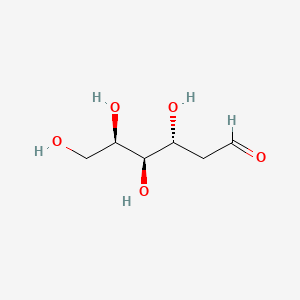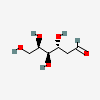2-Deoxy-D-galactose
- 2-Deoxy-D-galactose
- 1949-89-9
- D-lyxo-Hexose, 2-deoxy-
- (3R,4R,5R)-3,4,5,6-tetrahydroxyhexanal
- lyxo-Hexose, 2-deoxy-
- Create:2005-08-08
- Modify:2025-01-18
 2-Deoxy-lyxo-hexose (annotation moved to).
2-Deoxy-lyxo-hexose (annotation moved to).

- 2-deoxy-D-galactose
- 2-deoxy-lyxo-hexose
- 2-deoxy-lyxo-hexose, (D)-isomer
- 2-Deoxy-D-galactose
- 1949-89-9
- D-lyxo-Hexose, 2-deoxy-
- (3R,4R,5R)-3,4,5,6-tetrahydroxyhexanal
- lyxo-Hexose, 2-deoxy-
- 2-Deoxygalactose
- 2-deoxy-D-lyxo-hexose
- UNII-531K2IOK5Q
- 531K2IOK5Q
- EINECS 217-765-3
- 3,4,5,6-tetrahydroxyhexanal
- DTXSID9075163
- CHEBI:27411
- (+)-2-DEOXY-D-GALACTOSE
- 2-DEOXY-D-GALACTOSE, (+)-
- 2-deoxy-D-glucose
- 2-Desoxy-D-galactose
- SCHEMBL148114
- DTXCID8036108
- VRYALKFFQXWPIH-HSUXUTPPSA-N
- 2-DEOXY-BETA-D-LYXO-HEXOSE
- AKOS015896817
- AS-76274
- HY-131892
- CS-0142276
- D0050
- NS00026358
- 2FC857FA-DD30-40B9-AC50-1AEBCFB1A307
- Q27103117
 2-Deoxy-lyxo-hexose (annotation moved to)
2-Deoxy-lyxo-hexose (annotation moved to)Not Classified
Reported as not meeting GHS hazard criteria by 2 of 2 companies. For more detailed information, please visit ECHA C&L website.
Aggregated GHS information provided per 2 reports by companies from 1 notifications to the ECHA C&L Inventory.
Reported as not meeting GHS hazard criteria per 2 of 2 reports by companies. For more detailed information, please visit ECHA C&L website.
There are 0 notifications provided by 0 of 2 reports by companies with hazard statement code(s).
Information may vary between notifications depending on impurities, additives, and other factors. The percentage value in parenthesis indicates the notified classification ratio from companies that provide hazard codes. Only hazard codes with percentage values above 10% are shown.
Patents are available for this chemical structure:
https://patentscope.wipo.int/search/en/result.jsf?inchikey=VRYALKFFQXWPIH-HSUXUTPPSA-N
- CAS Common ChemistryLICENSEThe data from CAS Common Chemistry is provided under a CC-BY-NC 4.0 license, unless otherwise stated.https://creativecommons.org/licenses/by-nc/4.0/2-Deoxy-D-galactosehttps://commonchemistry.cas.org/detail?cas_rn=1949-89-9
- ChemIDplus2-Deoxy-D-galactosehttps://pubchem.ncbi.nlm.nih.gov/substance/?source=chemidplus&sourceid=0001949899ChemIDplus Chemical Information Classificationhttps://pubchem.ncbi.nlm.nih.gov/source/ChemIDplus
- EPA DSSToxD-lyxo-Hexose, 2-deoxy-https://comptox.epa.gov/dashboard/DTXSID90751632-Deoxy-lyxo-hexosehttps://comptox.epa.gov/dashboard/DTXSID30985215CompTox Chemicals Dashboard Chemical Listshttps://comptox.epa.gov/dashboard/chemical-lists/
- European Chemicals Agency (ECHA)LICENSEUse of the information, documents and data from the ECHA website is subject to the terms and conditions of this Legal Notice, and subject to other binding limitations provided for under applicable law, the information, documents and data made available on the ECHA website may be reproduced, distributed and/or used, totally or in part, for non-commercial purposes provided that ECHA is acknowledged as the source: "Source: European Chemicals Agency, http://echa.europa.eu/". Such acknowledgement must be included in each copy of the material. ECHA permits and encourages organisations and individuals to create links to the ECHA website under the following cumulative conditions: Links can only be made to webpages that provide a link to the Legal Notice page.https://echa.europa.eu/web/guest/legal-notice2-deoxy-D-galactosehttps://echa.europa.eu/substance-information/-/substanceinfo/100.016.1512-deoxy-D-glucose (EC: 205-823-0)https://echa.europa.eu/information-on-chemicals/cl-inventory-database/-/discli/details/360902-deoxy-D-galactose (EC: 217-765-3)https://echa.europa.eu/information-on-chemicals/cl-inventory-database/-/discli/details/105139
- FDA Global Substance Registration System (GSRS)LICENSEUnless otherwise noted, the contents of the FDA website (www.fda.gov), both text and graphics, are not copyrighted. They are in the public domain and may be republished, reprinted and otherwise used freely by anyone without the need to obtain permission from FDA. Credit to the U.S. Food and Drug Administration as the source is appreciated but not required.https://www.fda.gov/about-fda/about-website/website-policies#linking2-DEOXY-D-GALACTOSEhttps://gsrs.ncats.nih.gov/ginas/app/beta/substances/531K2IOK5Q
- Hazardous Substances Data Bank (HSDB)2-DEOXY-D-GLUCOSEhttps://pubchem.ncbi.nlm.nih.gov/source/hsdb/5484
- New Zealand Environmental Protection Authority (EPA)LICENSEThis work is licensed under the Creative Commons Attribution-ShareAlike 4.0 International licence.https://www.epa.govt.nz/about-this-site/general-copyright-statement/
- ChEBI2-deoxy-D-galactosehttps://www.ebi.ac.uk/chebi/searchId.do?chebiId=CHEBI:27411
- NCI Thesaurus (NCIt)LICENSEUnless otherwise indicated, all text within NCI products is free of copyright and may be reused without our permission. Credit the National Cancer Institute as the source.https://www.cancer.gov/policies/copyright-reuse
- ClinicalTrials.govLICENSEThe ClinicalTrials.gov data carry an international copyright outside the United States and its Territories or Possessions. Some ClinicalTrials.gov data may be subject to the copyright of third parties; you should consult these entities for any additional terms of use.https://clinicaltrials.gov/ct2/about-site/terms-conditions#Use
- Japan Chemical Substance Dictionary (Nikkaji)
- Metabolomics Workbench2-deoxy-D-galactosehttps://www.metabolomicsworkbench.org/data/StructureData.php?RegNo=51308
- Springer Nature
- Wikidata2-deoxy-D-galactose (open form)https://www.wikidata.org/wiki/Q27103117
- Wikipedia2-Deoxy-D-glucosehttps://en.wikipedia.org/wiki/2-Deoxy-D-glucose
- PubChem
- Medical Subject Headings (MeSH)LICENSEWorks produced by the U.S. government are not subject to copyright protection in the United States. Any such works found on National Library of Medicine (NLM) Web sites may be freely used or reproduced without permission in the U.S.https://www.nlm.nih.gov/copyright.html2-deoxy-lyxo-hexosehttps://www.ncbi.nlm.nih.gov/mesh/67019327
- GHS Classification (UNECE)GHS Classification Treehttp://www.unece.org/trans/danger/publi/ghs/ghs_welcome_e.html
- NORMAN Suspect List ExchangeLICENSEData: CC-BY 4.0; Code (hosted by ECI, LCSB): Artistic-2.0https://creativecommons.org/licenses/by/4.0/NORMAN Suspect List Exchange Classificationhttps://www.norman-network.com/nds/SLE/
- EPA Substance Registry ServicesEPA SRS List Classificationhttps://sor.epa.gov/sor_internet/registry/substreg/LandingPage.do
- MolGenieMolGenie Organic Chemistry Ontologyhttps://github.com/MolGenie/ontology/
- PATENTSCOPE (WIPO)SID 388374673https://pubchem.ncbi.nlm.nih.gov/substance/388374673

